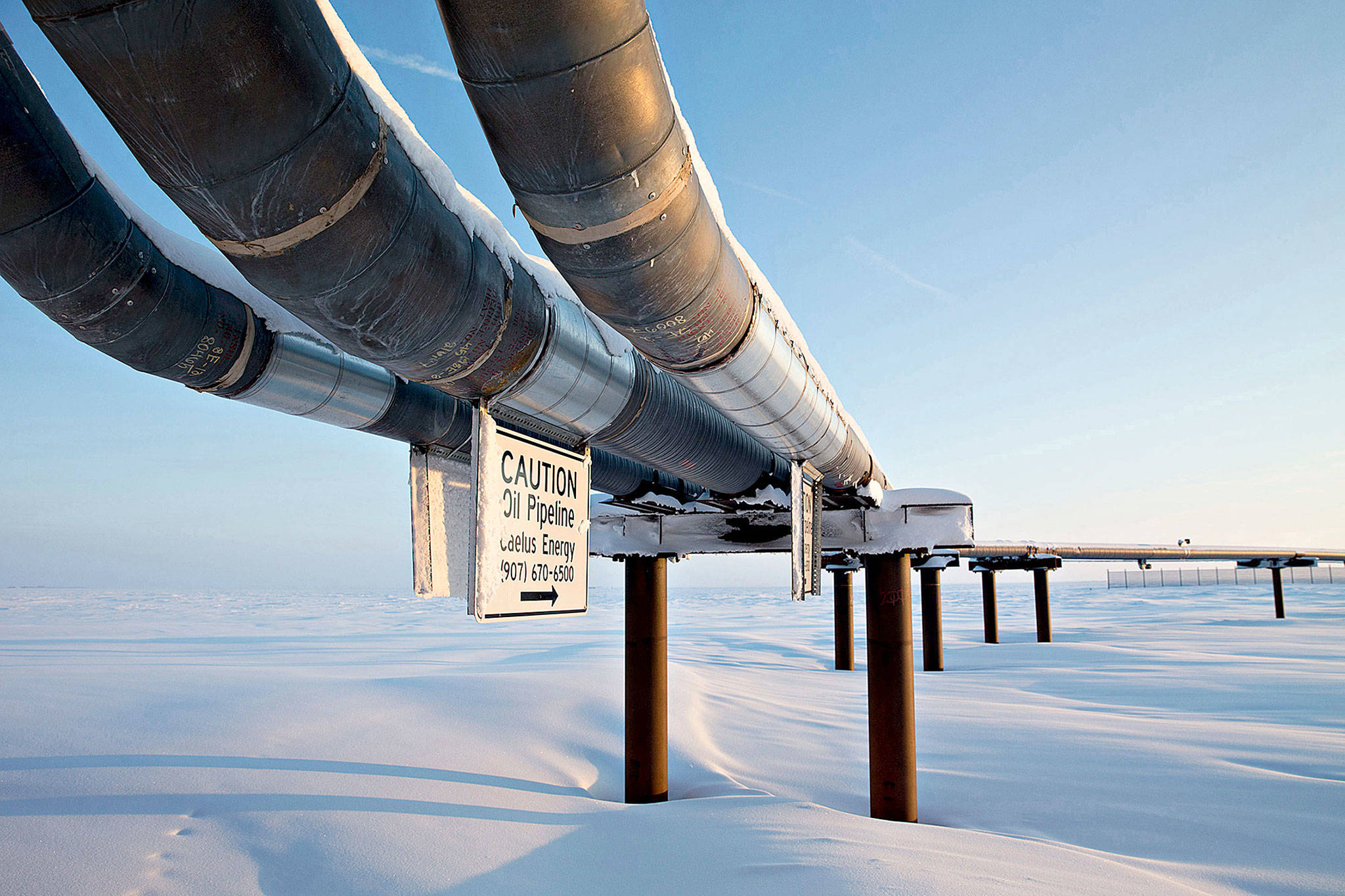By Alex Nussbaum, Bloomberg
Here at the top of the world, January brought a glimpse of the anxious future facing Alaska’s once-mighty oil pipeline.
The 800-mile Trans Alaska Pipeline System was built for extreme conditions. But as the state’s oil production has declined, the pipeline faces a new challenge: flows so sluggish operators worry the line may become unusable, cutting off access for hundreds of North Slope oil wells.
With the mercury dipping as low as -60 Fahrenheit, workers in January fired up heating units across the system. It worked, but if the brutal cold had lasted or the oil flow had slowed further, the pipeline would have been in uncharted territory. Four decades after it opened, Alaska’s pipeline — once a symbol of independence for an oil-strapped nation — is facing a midlife crisis. The line now moves a quarter of the volume it carried at its peak. And as the flows slow, the risks are rising.
“We’re already at the stress point,” said Tom Barrett, president of the Alyeska Pipeline Service Co., which operates the system. “We don’t have the kind of cushion you’d like to have.”
While new discoveries in Alaska have raised hopes recently, the state’s oil production has been falling for years. Most of the easy crude has been sucked out of Prudhoe Bay, the mammoth field on Alaska’s North Slope. And the availability of cheap shale in the lower 48 states means there’s less incentive for explorers to open new fields farther north, where drilling can be three times more expensive.
The result: Alaska’s output was 565,000 barrels a day last month, down from a peak of more than 2 million in 1988, according to state data.
Lower volumes mean crude travels more slowly through the pipeline, losing heat along the way. And at low temperatures, crude behaves badly. Ice crystals form that can damage pumping equipment. Carbon molecules, meanwhile, coalesce into paraffin, a waxy residue that, if not cleared out, can gunk up the line “like a big, frozen tube of ChapStick,” said Betsy Haines, Alyeska’s oil-movements director.
The pipeline opened for business on June 20, 1977, an American response to the OPEC oil embargo that brought the U.S. economy to a halt earlier in the decade. Some 70,000 workers trooped north to build the line, surmounting three mountain ranges, 30 rivers, howling Arctic winds and permafrost that crumpled steel pilings.
The project touched off a boom that left Alaska permanently tied to the fortunes of petroleum. State residents still get an annual check based on oil revenues. But as production and prices have tumbled in recent years, the state’s economy has suffered. State lawmakers in Juneau are grappling with a $3 billion budget deficit this year, along with one of the highest unemployment rates in the nation.
“We’re all concerned,” Gov. Bill Walker said. “We need to see oil in that pipeline. That’s our cash register. That’s what generates the revenue.”
At Prudhoe Bay’s Pump Station One, where oil starts its journey south, engineers are trying to keep the barrels moving. Outside, the station’s squat, olive-painted buildings sit amid an endless expanse of snow and ice. Inside, a maze of pumps and pipes collects oil flowing from wells across the North Slope. The lines are warm to the touch and even warmer to the wallet — at current prices, about $30 million worth of crude flows through the station daily.
Alyeska heats oil at Pump Station One to 100 degrees Fahrenheit, with a goal of keeping it above 37 degrees by the time it reaches the export terminal at Valdez, Alaska.
A joint partnership led by the North Slope’s top producers, BP, Exxon Mobil and ConocoPhillips, Alyeska has spent about $200 million upgrading equipment at Pump Station One alone. The partnership has added heating units up and down the route and raised buried sections of the line above ground. Another contingency plan calls for the injection of methanol, the chemical used in antifreeze, to keep supplies flowing.
Every four days, a device known as a pig, a sort of industrial Q-Tip, is sent hurtling through the 48-inch-wide pipeline to scrub out debris.
So far, that’s kept the oil moving. But it comes at a price: higher transport costs for a product that’s already at an economic disadvantage to other supplies around the globe. Alyeska’s technical fixes should allow the pipeline to keep operating at volumes as low as 300,000 barrels a day, a threshold that could be reached by the middle of the next decade, according to state estimates. Below that point, it’s unclear what will happen, according to Barrett, the Alyeska president.
“There’s just a lot of uncertainty about how we would solve that problem in a way that’s technically feasible and economically viable,” he said.
Recent discoveries by Caelus Energy and Repsol SA have raised hopes of opening up new, multibillion-barrel fields. Conoco, Exxon and BP, meanwhile, are doing all they can to squeeze more oil out of existing wells. The Big Three have borrowed techniques from shale frackers in the Lower 48, injecting torrents of natural gas and seawater underground to force up more oil.
But those efforts merely halted production declines, they didn’t reverse them. It may take years before the new finds ship significant quantities of oil — and then only if they prove economic in a world where prices have been locked in at around $50 a barrel.
West Texas Intermediate crude has traded in a range near that level since late last year. The U.S. benchmark was down 0.3 percent at $52.93 a barrel as of 9:54 a.m. London time on Tuesday.
“It’s all really a function of the oil price,” said Scott Digert, BP’s head of reservoir management in Alaska. “How long can you continue to operate an increasingly marginal field?”
Talk to us
> Give us your news tips.
> Send us a letter to the editor.
> More Herald contact information.

























